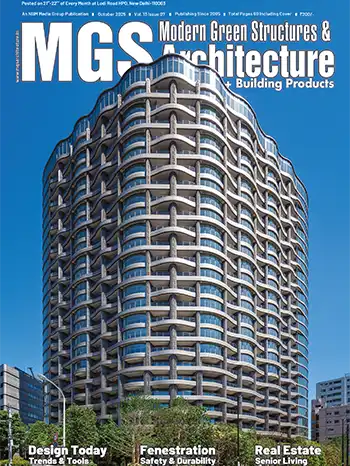Sushant Verma - Principal Architect, rat[LAB] Studio
 From L-R: Differentiated Facets, Patel Nager, New Delhi & Differentiated Facets, Patel Nager, New Delhi
From L-R: Differentiated Facets, Patel Nager, New Delhi & Differentiated Facets, Patel Nager, New DelhiSince its inception in 2012, rat[LAB] Studio has embraced a computational approach to architecture, positioning technology at the heart of its design philosophy. This focus has carved out a distinct niche where computation fuels innovation and redefines architectural and artistic boundaries.
 Bungalow 45, Sonipat, Haryana
Bungalow 45, Sonipat, HaryanaFor instance, The Differentiated Facets, a recently completed commercial project in Patel Nagar, New Delhi, exemplifies how computational design serves as a powerful tool for form exploration, environmental responsiveness, and material optimization. The project features 16 unique fins, each meticulously crafted and dynamically adjusted to respond to sunlight and ecological shifts. Early simulations informed this nuanced design, resulting in a facade that offers adaptability while maintaining a striking visual identity. Computational techniques streamlined the digital fabrication process, allowing each fin to be converted into CNC-cut elements that assembled seamlessly into the final structure.
 Tweening Arches, Head Field Head Quaters, Noida
Tweening Arches, Head Field Head Quaters, NoidaIn another instance, the Tweening Arches facade in Noida showcases intricate curves achieved through computational techniques. This method balances visual allure with structural integrity, while embedded lighting further enhances the aesthetic experience, blending technical precision with artistic intent. Tweening Arches stands as a testament to the union of beauty and functionality within a single facade, realized through computational mastery. The use of computational tools in this project involved understanding environmental factors such as solar radiation and lighting. Real-time analysis of these elements helped achieve an effective design. Such workflows can be effectively applied to sustainability and structural domains, with parametric detailing of geometry serving as a design strategy that would be exhaustive without computational tools.
Computation in architecture has evolved beyond a mere design utility; it has become a philosophy that guides projects from concept to refined construction. Continuously pushing the boundaries of what is possible, computational design not only brings projects to life but also sets a precedent for the future of architecture.
Sushant Verma
The striking appeal resulting from these design decisions is evident based on our analysis. These projects illustrate how a functional approach can yield aesthetically pleasing results. The primary intention was to maximize diffused light while minimizing radiation heat gain, which can serve as key parameters for generating designs that extend into generative design.
 Parametric Roof, Daman
Parametric Roof, DamanIn one of the ongoing parametric roofing projects in Daman, Gujarat highlights how computation enabled intricate modular detailing and rationalization for a highly complex form. Collaborating with structural experts, computational techniques divided the curved surfaces into over 650 unique panels, optimizing each 368 node and junction to withstand specific structural loads. This precision achieved efficient material usage without compromising stability or visual impact, underscoring how computation can balance material efficiency with expressive design in large-scale structures.
 Image of Delhi’s Pragati Maidan Complex ahead of G20. Source: NDTV article by Akhilesh Sharma
Computation Tool Development by rat[LAB] Studio & Architecture Design by ARCOP Associates
Image of Delhi’s Pragati Maidan Complex ahead of G20. Source: NDTV article by Akhilesh Sharma
Computation Tool Development by rat[LAB] Studio & Architecture Design by ARCOP AssociatesBeyond structural innovations, computational design has catalyzed the development of custom tools that enhance functionality and deepen design insight. For instance, a visibility analysis tool was developed for Bharatmandapam (New Pragati Maidan Auditorium project where rat[LAB] played the role of design technologist for rationalizing visibility, optimizing sightlines and seating arrangements to enhance user experience. Similarly, for the auditorium of Yashobhoomi (IICC Dwarka), such tools informed spatial layouts and acoustics for a 7000-seater auditorium, contributing to spaces that support and elevate the overall experience.

In both commercial and residential developments, computation-based tools continue to redefine design possibilities. With a focus on optimizing the Floor Area Ratio (FAR), these tools merge spatial efficiency with aesthetic appeal, showcasing how computation elevates architectural functionality. An early parametric modeling interface, developed in 2015, allowed users to adjust design parameters interactively, enabling the form to adapt dynamically to meet FAR requirements. This initiative exemplifies how computation can create a balanced, data-driven platform for design decisions, merging functional needs with visual engagement.
 SCO Rewari, Haryana
SCO Rewari, HaryanaEmbedded in this computational practice is a laboratory culture that merges academia with real-world application, fostering innovation through continuous exchange. Smart LABS by rat[LAB] Education encourages fresh ideas and research insights, feeding directly into studio work. This blend of educational outreach with professional practice enriches the studio’s projects, promoting a flow of ideas and talent that continuously shapes design methodologies and keeps computational design at the forefront of architectural technology.
 From L-R: Cellular Morphology Facade & Static Waves, Parametric Wall, Hyderabad
From L-R: Cellular Morphology Facade & Static Waves, Parametric Wall, HyderabadTo further enhance the design process, the integration of artificial intelligence and machine learning within computational design expands these possibilities. By incorporating AI with computational design, advances progress from reactive to predictive capabilities, enabling buildings to respond intelligently to environmental and user data. This progression foreshadows a future where architectural structures dynamically adapt, creating spaces that meet the evolving needs of their occupants.

![Sushant Verma Principal Architect, rat[LAB] Studio](/images/Technology-Automation/4063-rat-Studio-4.jpg)













